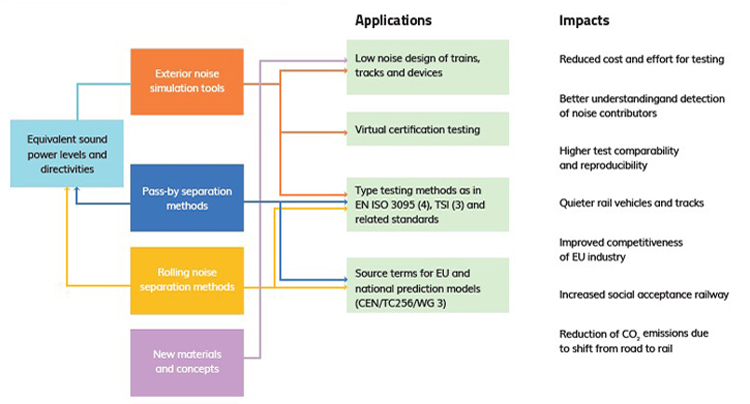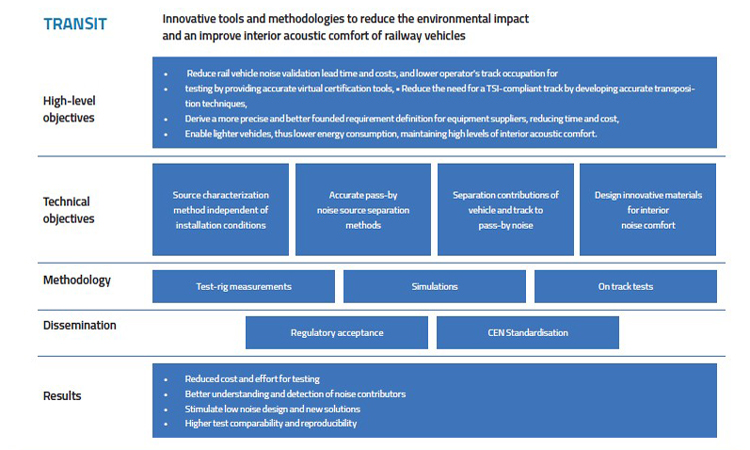The TRANSIT project: Innovation towards train pass‑by noise source characterisation and separation tools
Posted: 9 February 2022 | David Thompson, Ennes Sarradj, Ester Cierco Molins, Inés López, Juan Moreno García-Loygorri, Marta Garcia, Martin Rissmann, Mats Åbom, Michael Dittrich | No comments yet
Railway transport produces less CO2 and consumes less energy than road and air transport modes; it also requires less space than road transport. However, noise and vibration (N&V) levels in the vicinity of railways are a major environmental challenge for the railway sector. In addition, a competitive railway transport system demands better passenger comfort. In this article, we discover how the TRANSIT project is responding to these very issues.


Noise reduction is addressed to some extent by the requirement of the Technical Specifications for Interoperability (TSI) for all new vehicles to meet noise limits in both pass-by and stationary conditions. Due to the high cost involved in such tests, and the need for a track section with specific properties, it is desirable to develop virtual testing and some progress has been made in a previous project (ACOUTRAIN) towards this.
In addition, advanced measurement methods are required that can identify the noise contributions of different sources on an operational train. The relative importance of the various sources on the vehicle as well as the track, needs to be better understood.
The overall goal of the TRANSIT project is to provide the railway community with a proven set of innovative tools and methodologies to reduce the environmental impact and improve interior acoustic comfort of railway vehicles. Therefore, the main objectives of the TRANSIT project are:
- To reduce lead time and costs of rail vehicle noise certification, and lower track occupation requirement for testing by providing accurate virtual certification tools
- To reduce the need for a TSI-compliant track by developing and demonstrating accurate separation and transposition techniques
- To derive a more precise and better-founded definition of acoustic requirements for equipment suppliers, reducing time and cost
- To deliver improved source quantification for use in noise mapping and a more accurate assessment of noise abatement measures
- To enable lighter vehicles, thus lower energy consumption, while maintaining high levels of interior acoustic comfort.
A summary of the impacts and applications of the TRANSIT project is given in Figure 1.


FIGURE 1:SUMMARY OF TRANSIT APPLICATIONS AND IMPACTS
The TRANSIT consortium brings together members with considerable experience in the railway sector. They bring leading-edge knowledge on topics ranging from best practice in the use of computer aided engineering tools for virtual prototyping and certification of products, to advanced measurement methods such as microphone array technologies for source separation.
Most of the activities in TRANSIT are focused on the experimental characterisation, modelling and separation of railway noise sources (at standstill and during pass-by) as well as the further development of the ACOUTRAIN external noise prediction tool to account for installation effects in the transmission paths. New test methods are also developed to quantify noise transmission paths from sources on rail vehicles to microphone positions beside the track accounting for installation effects.
In addition, the project is also focused on the investigation on innovative materials and methods for an improved sound comfort. New and innovative approaches will be used to improve the design of the interior acoustics of future rolling stock. Several possible approaches are being considered, including optimal sound absorption at the source, damping along ducts for air conditioning systems and innovative meta‑structure designs for the car-body parts.
Figure 2 represents the global approach of the TRANSIT project, in particular the translation of the high-level objectives into technical objectives. It also shows the methodology implemented within the project.


FIGURE 2: TRANSIT – FROM OBJECTIVES TO RESULTS
The main expected impacts of TRANSIT arise from the methods and tools that will give a better understanding and quantification of the contribution of the different sources to the total pass-by noise. That will, in turn, lead to innovations in low noise design of vehicles and tracks, virtual certification testing, and the derivation of source terms for EU and national prediction models, among others.
The following four work streams are addressed, with specific technical achievements already reached:
1. Source and transmission characterisation for exterior noise
Source characterisation based on equivalent monopoles has been presented with a new simplified procedure assuming uncorrelated monopoles. The simplified procedure is based on sound power data determined via an ISO standard procedure, e.g. ISO 3744 or 9614. A calibrated monopole source is used to characterise the transmission and the simplified procedure has been validated for generic sources in the report (D1.1): “Validated procedure for source characterisation based on equivalent monopoles and tests involving generic sources”. The ACOUTRAIN external noise prediction tool will be extended to account for installation effects in the transmission paths such as shielding. This will enable developments of virtual testing and homologation of new vehicles.
2. Pass-by noise source separation
The aim here is to obtain the sound power level and directivity of noise sources during pass by at constant speed of a train. The main sources considered are aerodynamic noise, traction noise, equipment noise and rolling noise. At least two different methods are investigated: one based on a microphone array and the other using a single microphone and rail-mounted accelerometer (PBA‑based).
Pass-by noise source separation using a microphone array consists of measurement of train pass-by noise with a planar arrangement of microphones (at least 64 channels) and the use of acoustic imaging techniques for source separation (beamforming, advanced spatial filtering deconvolution, inverse methods).
3. Separation of track noise and vehicle noise
TRANSIT is working on the development of enhanced methods for separating vehicle and track contributions to rolling noise. The TSI Noise specifies noise limits for new vehicles which have to be measured on a track with a low contribution to the noise, specified in terms of track decay rate and rail roughness level. Nevertheless, the track noise (and roughness) is still an important contributor to the overall level. This makes it difficult to compare results from different sites; moreover, further reductions in vehicle contribution may be masked by the track noise. It is therefore important to be able to separate the contributions of vehicle and track, to identify and promote low noise design. The proposed method should be applicable as an extension to the TSI Noise procedure.
4. Innovative designs in materials and methods for interior noise
Finally, TRANSIT is also working in exploring innovative approaches and material designs for an improved interior sound comfort. This started with a feasibility study for several potential solutions to proposed case-studies and is continuing with an in‑depth analysis of the two most promising solutions. Innovative designs and methods are being studied, focusing on meta-structure designs and other tailored material design. Acoustic performance characterisation of baseline and new designs is carried out through simulation or smallscale measurements and acoustic performance of new designs will be validated in realistic conditions.
Summary of the main innovations in TRANSIT
The main challenge for current vehicle certification methods is the fact that the track is a significant contributor to pass-by noise whereas current techniques are unable to accurately separate vehicle and track contributions. TRANSIT is targeting this problem by developing methods to identify the contribution of vehicle sources and to separate the vehicle and track contributions to rolling noise.
Based on the analyses and methods developed within TRANSIT, the project aims to enable future low noise railway vehicles with a reduced environmental impact and an improved interior acoustic comfort. This is achieved by developing accurate and robust source characterisation and separation methods and techniques, and exterior noise simulation tools that will make virtual testing and more cost-effective vehicle certification and homologation methods possible. For interior noise control, innovative material designs to increase sound transmission loss and absorption will lead to an improved interior sound quality within the weight constraints.
The key to predicting overall noise levels accurately for stand-still or in the vicinity of the track during pass-by is an accurate separation and characterisation of the main contributing sources and this is the core of the research work in TRANSIT.
TRANSIT is firmly based on the results from past EU projects ACOUTRAIN and Roll2Rail and relies on the inputs from EU projects FINE-1 and FINE-21 to set the next steps towards virtual certification. Furthermore, a key aspect to maximise the visibility, impact and acceptance of the TRANSIT results is the interaction with relevant stakeholders such as the steering committee of the Shift2Rail Cross- Cutting Activities (CCA), the EU Agency for Railways (ERA) and TC256/WG3 of the European Committee for Standardization (CEN).
For further information about the project and partners, please, visit the project website.
Reference
- Noise and vibration work in the FINE-2 project – Global Railway Review, Volume 27, Issue 6 2021, pages 12-15
Authors
Inés López, Project Coordinator, Technische Universiteit Eindhoven (TUE)
Mats Åbom, KTH, Royal Institute of Technology (KTH)
Ennes Sarradj, Technical University of Berlin (TUB)
David Thompson, ISRV, University of Southampton
Marta García, Union des Industries Ferroviaires Européennes (UNIFE)
Ester Cierco Molins, Ingeniería para el Control del Ruido (ICR)
Michael Dittrich. Netherlands Organization for Applied Scientific Research (TNO)
Martin Rissmann, Vibratec
Juan Moreno García-Loygorri, Metro Madrid
The SILVARSTAR project received funding from the European Union’s Horizon 2020 research and innovation programme under grant agreement N 101015442. This document reflects only the authors’ views and that the JU is not responsible for any use that may be made of the information it contains.
Issue
Related topics
Noise & Vibrations, Rolling Stock Components (Interior/Exterior), Technology & Software, Track/Infrastructure Maintenance & Engineering
Related organisations
Ingeniería para el Control del Ruido (ICR), KTH Royal Institute of Technology (KTH), Metro Madrid, Netherlands Organization for Applied Scientific Research (TNO), Technical University of Berlin (TU Berlin), Technische Universiteit Eindhoven (TUE), UNIFE (the European Rail Supply Industry), University of Southampton, Vibratec








